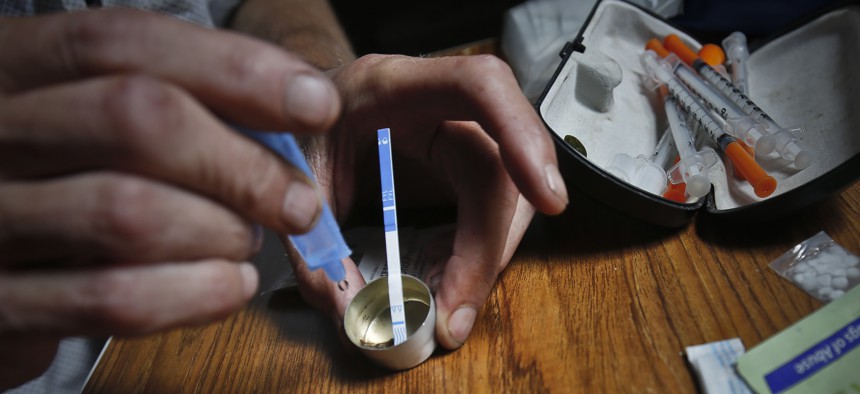The Drop in Drug Overdose Deaths Missed Some States

An addict prepares heroin, placing a fentanyl test strip into the mixing container to check for contamination, Wednesday Aug. 22, 2018, in New York. If the strip registers a "pinkish" to red marker then the heroin is positive for contaminants. Bebeto Matthews/AP Photo
The number of fatal drug overdoses dipped by 5% in the United States last year, but in Missouri deaths increased 16 percent. Experts blame the uptick in deaths on the influx of fentanyl sold in the state.
As the drugs fueling the opioid crisis are shifting—from prescription pain pills to fentanyl—so too is the epidemic’s epicenter.
Drug overdose deaths are now taking a higher toll in big cities than the rural areas that had been associated with the epidemic in recent years, according to data from the Centers for Disease Control and Prevention. It’s a trend exemplified in Missouri, where drug overdose deaths increased 16% last year and opioid-related deaths became increasingly concentrated in the St. Louis region.
While the number of fatal drug overdoses fell by 5% in the United States last year, Missouri was one of 17 states that bucked the national downward trend. Instead, the Show-Me state saw deaths from drug overdoses increase from 1,406 in 2017 to 1,635 last year, according to estimates released this month by the CDC.
The only other state that saw a larger increase in 2018 was Delaware, where fatal overdoses jumped 16.7% to 399 deaths.
The national 5% decline coincides with a geographic shift in where overdose deaths are happening. From 2007 to 2015, overdose death rates in rural counties outpaced those in urban counties. But a spike in overdose deaths in cities pushed urban areas to outpace rural areas 2016, the CDC data showed.
Experts said the shift is likely related to the increased use of fentanyl or drugs laced with the synthetic opioid. Fentanyl is considered 80 times stronger than morphine, and can be lethal in very small doses.
More than half of Missouri’s opioid-related deaths occurred in St. Louis and the surrounding counties, said Dr. Randall Williams, director of Missouri’s Department of Health and Senior Services.
“Many people, they think they are getting heroin but dealers lace it with fentanyl for a variety of reasons,” he said.
More than 90% of the opioid overdose deaths in St. Louis last year were attributable to fentanyl, said Rachel Winograd, an associate research professor at the University of Missouri-St. Louis’ Missouri Institute of Mental Health.
The increase in fatal overdoses is not necessarily because more people are using drugs, but rather because more people are dying from the drugs they are using, she said.
Drug traffickers are routinely mixing fentanyl with heroin and other drugs or pressing it into counterfeit prescription pills, the Drug Enforcement Administration warned in its 2018 National Drug Threat Assessment.
As individuals who became addicted to prescription opioids have started to turn to heroin or synthetic opioids, they are at a greater risk of ingesting a fatal potent dose of fentanyl, Williams said.
Were fentanyl to hit rural parts of Missouri the way it has in St. Louis, Williams said overdose deaths would be on the rise there as well. He suspects traffickers stick to the large cities to sell fentanyl because they would stick out too much if they travelled to small towns. Unlike fentanyl or heroin, prescription opioid users who became addicted were able to get their drugs from local pharmacies.
The St. Louis-based Missouri Network for Opiate Reform and Recovery provides about 100 drug testing kits to people a month so they can test their drugs to determine whether or not they contain fentanyl. But fentanyl is so ubiquitous in the city, that some users have given up testing heroin because it’s always cut with the synthetic opioid, said Chad Sabora, the group’s co-founder and executive director.
“The fact is, users cannot even get heroin anymore is an issue. All they can get is fentanyl,” he said.
Sabora said he encourages people who use methamphetamines and cocaine to test their drugs because traffickers have also begun adulterating those drugs with fentanyl.
Federal grants for purchase of the overdose-reversal drug Narcan have helped to deploy life-saving help to thousands around the state, Winograd said.
The Missouri Opioid-Heroin Overdose Prevention and Education (MO-HOPE) Project has distributed more than 10,000 kits of Narcan across the state, and tracked upwards of 3,600 successful overdose reversals.
But to help people recover from drug addictions, individuals need any easier path to get into treatment and recovery programs, experts said. Expansion of the state’s Medicaid program to include low-income residents would help people suffering from drug addiction get beds at in-patient facilities, Sabora said.
Missouri is one of 14 states that hasn’t expanded Medicaid to cover low-income individuals. Missouri HealthNet, the state’s Medicaid program, covers only disabled people, pregnant women and children and some seniors.
Studies have shown that approximately 232,000 uninsured people would be eligible for Medicaid if Missouri expanded the program.
Earlier this month, Gov. Mike Parson created a task force that could look at expanding Medicaid. But Parson, a Republican, has said he has concerns about people who aren’t eligible being covered by the insurance program.
Missouri also remains the only state in the country without a state-run prescription drug monitoring program. St. Louis County has started its own monitoring program, which other municipalities across the state have joined.
Sabora estimates he gets five phone calls a day from people looking for recovery help who would qualify for Medicaid if the state expanded the program to more low-income people.
“It is a huge stumbling block,” he said.
Andrea Noble is a staff correspondent for Route Fifty.
NEXT STORY: The Country's Most Sweeping Paid Family Leave Policy Just Became Law





